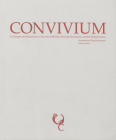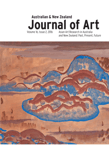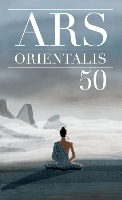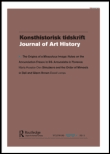
Convivium-Exchanges and Interactions in the Arts of Medieval Europe Byzantium and the Mediterranean
Scope & Guideline
Connecting Scholars in the Study of Byzantine and Mediterranean Arts
Introduction
Aims and Scopes
- Interdisciplinary Approaches to Medieval Art:
The journal emphasizes the integration of various disciplines such as art history, archaeology, theology, and cultural studies to analyze medieval artistic practices and their socio-political contexts. - Exploration of Cross-Cultural Interactions:
A core focus is on the interactions between different cultures within the medieval period, particularly how Byzantine, Latin, and Islamic art influenced each other across regions, emphasizing the Mediterranean as a dynamic space for exchange. - Narratives of Memory and Identity:
The journal investigates how narratives surrounding memory, identity, and historical events were constructed through visual culture, exploring the role of art in shaping collective memories and cultural identities. - Regional Studies with a Global Perspective:
While the journal publishes works focusing on specific regions (e.g., Venice, Armenia, Svaneti), it situates these studies within broader global interconnections, providing a comprehensive understanding of medieval art's evolution. - Digital Humanities and New Methodologies:
The journal encourages contributions that utilize digital humanities methods to analyze and visualize medieval art and architecture, promoting innovative approaches to historical research.
Trending and Emerging
- Digital Approaches to Art History:
There is a growing emphasis on the use of digital tools and methodologies to analyze, visualize, and disseminate research on medieval art, highlighting the importance of technology in contemporary scholarship. - Gender and Intersectionality in Medieval Studies:
Emerging themes related to gender, sexuality, and race are increasingly present, with scholars examining how these factors influenced artistic production and representation in the medieval period. - Environmental and Material Culture Studies:
Recent publications show a trend towards exploring the relationship between art and its materiality, as well as the environmental contexts in which medieval art was created and experienced. - Revisiting Historical Narratives:
There is an increasing trend of re-evaluating established historical narratives, particularly in relation to identity and memory, and how these narratives are expressed through visual culture. - Interdisciplinary Dialogues on Religious Art:
The journal is seeing a rise in interdisciplinary studies that connect religious art to broader themes such as ritual, performance, and sensory experiences, reflecting a deeper exploration of the spiritual dimensions of medieval artwork.
Declining or Waning
- Traditional Iconography Studies:
There has been a noticeable decline in papers focusing solely on traditional iconography without contextual analysis. Scholars are increasingly seeking interdisciplinary approaches that integrate iconography with broader cultural narratives. - Static Interpretations of Art:
Papers that offer static or singular interpretations of artworks are becoming less common, as the journal's contributors favor dynamic, multifaceted analyses that consider varying perspectives and interpretations across different contexts. - Narrow Regional Focus:
While regional studies remain important, there is a declining trend in works that focus exclusively on isolated regional narratives without connecting them to wider Mediterranean or cross-cultural dialogues.
Similar Journals

Wacana Seni-Journal of Art Discourse
Elevating Art Discourse for a Global Audience.Wacana Seni-Journal of Art Discourse, published by Penerbit Universiti Sains Malaysia, is a premier academic journal that has been a pivotal platform for the exploration and engagement of interdisciplinary studies within the fields of Cultural Studies, Music, and Visual Arts and Performing Arts. With its ISSN 1675-3410 and E-ISSN 1985-8418, the journal has established itself as an influential resource since its inception in 2011, now spanning up to 2023. Recognized in the Q2 category within multiple disciplines, Wacana Seni ranks impressively among its peers, reflecting its commitment to high-quality research, as evidenced by its admirable rankings within Scopus. The journal aims to foster dialogue and disseminate cutting-edge scholarship that enhances the understanding and appreciation of art in its myriad forms, thus inviting contributions from researchers, professionals, and students alike to further enrich the discourse in the arts. Based in Penang, Malaysia, and committed to open access, Wacana Seni serves as a vital conduit for knowledge exchange within the global art community.

GOYA
Connecting Creativity with Critical ThoughtGOYA, published by the esteemed FUNDACION LAZARO GALDIANO, is a pivotal journal in the field of Visual Arts and Performing Arts. With an ISSN of 0017-2715, this Spanish journal serves as a critical platform for scholars, artists, and practitioners to engage with contemporary issues, trends, and methodologies in the arts. Since its inception, GOYA has strived to illuminate the intersection of artistic expression and cultural discourse, with coverage spanning from 2002 to 2024. The journal proudly holds a Q3 category ranking in the 2023 Scopus assessments for its field, reflecting its respected position among peers, with a notable rank of #377 out of 667. Though it does not follow an Open Access model, GOYA continues to contribute significantly to the academic landscape, enabling a deeper understanding of artistic practices and their societal implications. Researchers and students alike will find the journal an invaluable resource for insights and inspiration within the dynamic realm of the arts.

Australian and New Zealand Journal of Art
Illuminating Contemporary Artistic DiscoursesThe Australian and New Zealand Journal of Art, published by Taylor & Francis Ltd, stands as a critical platform for scholarly discourse in the fields of art, visual arts, and performing arts, contributing to the ongoing dialogue regarding contemporary artistic practices and methodologies across Australia and New Zealand. With an ISSN of 1443-4318 and an E-ISSN of 2203-1871, this journal invites submissions that strive for innovation and insightful critique, aiming to foster a deeper appreciation and understanding of diverse artistic expressions. Despite its classification in the fourth quartile under the Arts and Humanities categories, it continues to attract attention within its niche, as evidenced by its Scopus rankings, indicating its vital role in the academic landscape. The journal is committed to bridging the gap between research and practice, providing access to a wealth of interdisciplinary knowledge for researchers, professionals, and students alike.

Baltic Journal of Art History
Fostering Innovative Research in the Baltic RegionBaltic Journal of Art History is a prominent academic journal published by UNIV TARTU PRESS, focusing on the rich tapestry of art historical research within the Baltic region and beyond. With its ISSN 1736-8812 and E-ISSN 2346-5581, the journal serves as a vital platform for scholars, artists, and historians to disseminate innovative findings and critical analyses in the fields of History and Visual Arts and Performing Arts. Established in 2017, it has gained recognition in academic circles, achieving a Q3 ranking in History and a Q2 ranking in Visual Arts and Performing Arts as of 2023. Despite not being open access, the journal continues to attract a diverse readership eager to engage with its rigorous, peer-reviewed content. Situated in Estonia, the journal not only enriches the regional scholarly discourse but also contributes significantly to global conversations on art history. Positioned at a pivotal intersection of various disciplines, the Baltic Journal of Art History invites researchers and practitioners alike to explore the aesthetic and cultural narratives that shape our understanding of art.

Quiroga-Revista de Patrimonio Iberoamericano
Connecting Cultures: Preserving the Past, Inspiring the FutureQuiroga-Revista de Patrimonio Iberoamericano, published by UNIV GRANADA, is a distinguished open-access journal dedicated to the fields of conservation, museology, and the visual and performing arts. Since its inception in 2012, the journal has provided a platform for scholars and practitioners to disseminate innovative research and critical discussions pertinent to Ibero-American heritage. With a growing impact, evidenced by its category quartiles ranking—Q3 in Conservation and Q2 in both Museology and Visual Arts and Performing Arts—as well as its Scopus rankings, Quiroga serves as an essential resource for researchers, professionals, and students who engage with the complexities of cultural preservation and artistic expression. The journal’s commitment to open access ensures the widespread availability of knowledge, fostering academic dialogue and collaboration within the global community. For inquiries, the journal can be reached at their offices located in Granada, Spain.

ARS Orientalis
Bridging Tradition and Modernity in ScholarshipARS Orientalis is a distinguished academic journal published by the Smithsonian Institution's Freer Gallery of Art, specializing in the fields of archaeology, cultural studies, and the visual and performing arts. With an ISSN of 0571-1371, this journal contributes significantly to scholarly discourse, having established a robust timeline of publication since its inception, notably from 2001 to 2006, 2010 to 2012, 2014 to 2017, and resuming again from 2022 to 2023. Though currently not open access, it maintains a respectable standing in the academic community with a categorization into Q3 quartiles across several disciplines, highlighting its relevance amid rigorous scholarly evaluation. The journal is particularly valuable for researchers, professionals, and students who seek to explore interdisciplinary connections within its scope. Situated in the United States, it aims to disseminate insightful research that bridges the gap between traditional scholarship and contemporary studies in visual culture and archaeological findings.

Kunstiteaduslikke Uurimusi
Illuminating Estonia's Rich Artistic HeritageKunstiteaduslikke Uurimusi is a notable academic journal published by the Estonian Society Art Historians, dedicated to the exploration and analysis of art and cultural studies within the vibrant context of Estonia and beyond. With an ISSN of 1406-2860, this journal offers a platform for researchers, professionals, and students to disseminate their findings and engage in meaningful discourse in the fields of Arts and Humanities and Cultural Studies. Although it occupies a fourth quartile ranking in both fields, the journal's commitment to fostering scholarly dialogue is evident through its open access provision, facilitating the sharing of knowledge across disciplines. Covering a broad spectrum of art historical themes since its inception, Kunstiteaduslikke Uurimusi aims to contribute to the understanding of artistic practices and cultural phenomena, making it an essential resource for those interested in the intersections of art, culture, and society. The journal continues to evolve, with coverage extending from 2011 to 2024, reflecting the dynamic nature of the arts and cultural sectors.

Artnodes
Fostering Interdisciplinary Connections in Art and ScienceArtnodes is a prominent academic journal published by UNIV OBERTA CATALUNYA, making significant contributions to the interdisciplinary fields of Arts and Humanities, Cultural Studies, and Computer Science. With an ISSN of 1695-5951 and an E-ISSN of 1695-5951, this Open Access journal has been accessible to the global community since 2002, encouraging the dissemination of innovative research and artistic exploration. Distributed from its headquarters in Barcelona, Spain, Artnodes has established itself as a vital resource, particularly in the domains categorized under Visual Arts, Performing Arts, and Literature, boasting a Q1 ranking in several areas for 2023. The journal is also noted for its impact in computer graphics and design, highlighting the integration of technology and art. With an impressive Scopus rank of #134 in Visual Arts and Performing Arts, this journal remains a critical forum for scholars and practitioners alike, facilitating dialogue and advancing knowledge across disciplines.

KONSTHISTORISK TIDSKRIFT
Unveiling Artistic Narratives Through TimeKONSTHISTORISK TIDSKRIFT is a distinguished journal dedicated to the exploration of art history and its intersections with visual and performing arts. Published by Routledge Journals, Taylor & Francis Ltd, this esteemed publication has been a vital resource for scholars and professionals alike since its inception in 1932, with a mission to advance the understanding of historical and contemporary artistic expression. Operating from the United Kingdom, it currently occupies a commendable Q3 Quartile ranking in both History and Visual Arts and Performing Arts categories for 2023, according to Scopus metrics. With an engaging array of peer-reviewed articles, the journal serves as a platform for critical discourse, fostering an inclusive intellectual community. As it looks ahead to its convergence into 2024, KONSTHISTORISK TIDSKRIFT promises to enrich the academic landscape with impactful research and insights, making it a vital resource for researchers, professionals, and students passionate about the field.

Anales de Historia del Arte
Unlocking the Secrets of Artistic InnovationAnales de Historia del Arte is a distinguished open-access journal published by Univ Complutense De Madrid, focusing on the diverse fields of art history, visual arts, and performing arts. Since its inception in 2005, this journal has provided a platform for scholars and researchers to disseminate original research, critical reviews, and theoretical discussions that enhance the understanding of artistic developments throughout history. Located in Madrid, Spain, and embracing a global perspective, it plays a crucial role in fostering dialogue within the arts and humanities sectors. The journal is currently categorized in the Q4 quartiles of its respective fields according to Scopus metrics, ranking among approximately 15-25% of publications within the arts and humanities domains as of 2023. Researchers and academics can take advantage of the open-access model, allowing for wider dissemination of knowledge and enhancing the accessibility of critical discourse in art history. Explore Anales de Historia del Arte for its significant contributions to emerging trends and established research in the arts.